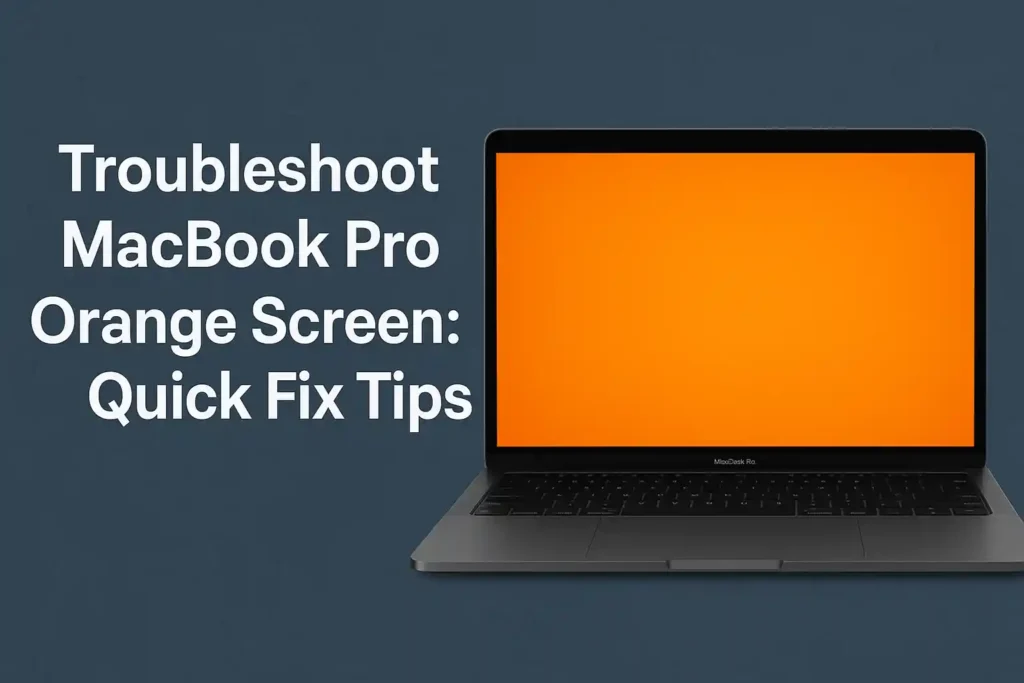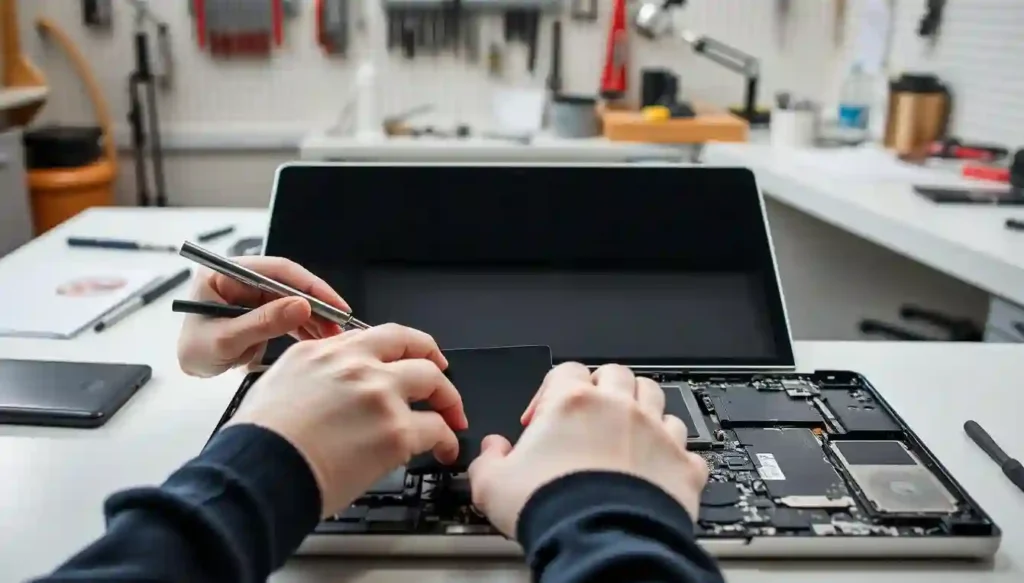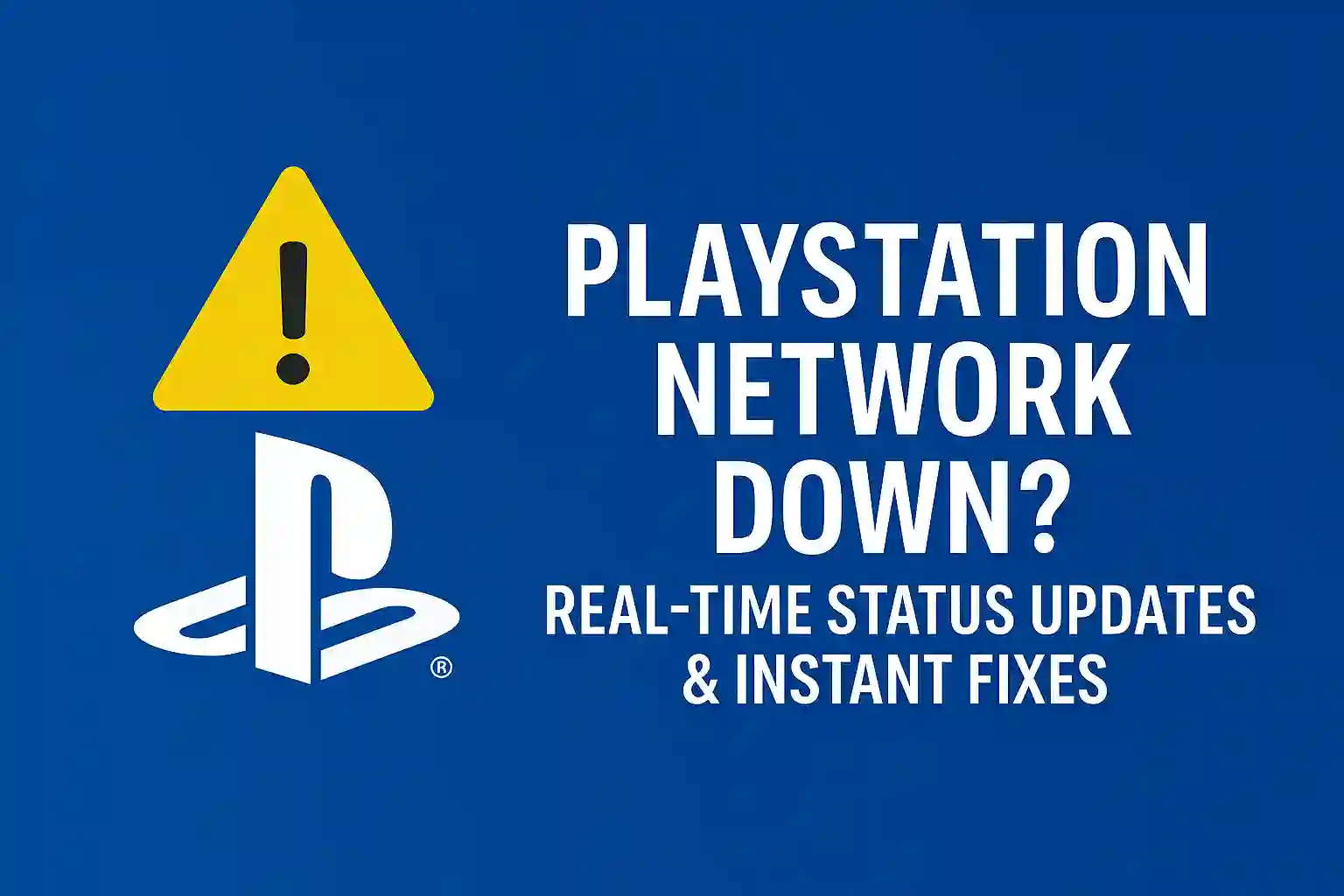Troubleshoot MacBook Pro Orange Screen: Quick Fix Tips

Table of Contents
ToggleIs your Apple laptop glowing like a Halloween decoration? That orange tint on your screen is not just weird—it might mean something serious is wrong. Many think it’s just a software problem, but it could be a hardware issue that needs quick action.
This guide will help you figure out if it’s a simple glitch or a big problem. We’ll show you how to tell if it’s a software issue or physical damage. Time is important when you see strange colors. Waiting too long could cause permanent damage or lose your data.
You’ll learn how to check your device’s parts, reset important settings, and know when to call a pro. Whether it’s a bad app or a failing part, we have clear fixes for Apple’s top laptops.
Key Takeaways
- Orange screens often stem from GPU errors or display cable failures
- Safe Mode testing helps isolate software vs hardware causes
- Resetting NVRAM/PRAM frequently resolves color distortion issues
- Persistent orange hues may indicate costly component replacements
- Apple Diagnostics Tool provides official hardware verification
Understanding the Orange Screen Issue on MacBook Pro
MacBook Pro users see an orange screen and wonder what it means. This color usually shows a problem between hardware and software. It happens in different ways and with different MacBooks.
What the Orange Tint Indicates
The orange screen often means one of three things:
- Color calibration errors from bad display profiles
- Firmware problems during startup
- Damage to display cables or connectors
Apple techs say the orange is often due to display voltage issues. This color doesn’t go away like Night Shift does. It stays the same in all apps and after restarting.
Startup Screen vs Operational Display Issues
It’s easier to figure out the problem if you know when it happens:
| Startup Phase | Runtime Operation |
|---|---|
| POST failures showing orange bars | Gradual color temperature shifts |
| EFI firmware conflicts | GPU rendering errors |
Orange screens at startup often mean logic board problems. But, orange during use might be from too much graphics work or heat.
Affected Models (2016-2020)
Apple’s older laptops are more likely to have issues because of:
- Thin LCD flex cables that break easily (Flexgate issues)
- T2 chip display problems
- Double GPU models that have trouble switching
The 2018-2019 13″ MacBook Pro is the most common problem, says repair data. Even the 2020 models, with new flex cables, can fail too.
READ ALSO – Laptop Overheating? 11 Quick Fixes to Cool It Down Fast
Common Causes of Orange Display Problems
When your MacBook Pro screen turns orange, it’s usually because of software bugs or hardware problems. Finding out why needs you to know how macOS handles screen colors and look for signs of wear. Let’s explore the main reasons for this orange screen issue.
Software-Related Triggers
macOS color profile conflicts can cause unexpected orange tints. The system uses ICC profiles for color accuracy. If an app changes these settings or a profile gets damaged, orange might appear.
Features like Night Shift and True Tone adjust screen colors based on light. But bugs can make them too warm. A new macOS update or graphics driver issues can make things worse, if graphics switching doesn’t work right.
Hardware-Related Causes
GPU failure signs often show as orange screens. Graphics chips in older MacBooks can wear out from heat. This makes colors look wrong. Heat buildup from bad thermal paste speeds up this damage.
Backlight problems are another hardware issue. The LED array needs the right voltage for white balance. If it’s damaged or old, it might show orange. Physical damage to the display cables can also mess up color signals.
Other issues include liquid damage or pressure on the screen. These problems need a pro to figure out, as they can look like software bugs.
Immediate Response Protocol
When your MacBook Pro flashes an orange screen, act fast to avoid damage. Follow these steps to keep your device stable and check for temporary problems.
Forced Restart Procedure
Use this sequence for Intel-based MacBooks:
- Press Command + Control + Power at the same time
- Hold for 10 seconds
- Release and wait 30 seconds before restarting
This MacBook hard reset fixes temporary system errors that might cause display issues. If the orange tint stays after reboot, check your peripherals.
Disconnecting Peripherals
External devices can cause display problems:
- Unplug all USB-C/USB-A accessories
- Remove SD cards and external drives
- Disconnect secondary displays
Test your screen after each removal to find the issue. Some docking stations can conflict with macOS’s color profiles.
Cooling Down Overheated Devices
Thermal stress often affects 2016-2020 Intel models. Use these thermal throttling solutions:
| Method | Procedure | Effectiveness |
|---|---|---|
| Active Cooling | Place on hard surface with laptop cooler | Reduces temps by 8-12°F |
| Workload Reduction | Close CPU-intensive apps | Immediate thermal relief |
| Environment Control | Move to cooler room (below 75°F) | Prevents thermal throttling |
Let your device cool for 15 minutes before checking the display again. If the orange color doesn’t go away, it might be a deeper hardware problem.
READ ALSO – Windows 11 Problems After Update? Here’s How to Fix Crashes, Lag, and Bugs (2025 Guide)
Display Settings Adjustments
Adjusting your MacBook Pro’s display settings can fix orange screen issues. macOS has tools to control color and display settings. These tools use sensors to help.
Resetting Color Profiles
The ColorSync Utility keeps colors accurate in macOS apps. To fix corrupted profiles:
- Open Finder > Applications > Utilities
- Launch ColorSync and select “Profiles”
- Right-click System Profiles folder > Reset
This resets the P3 wide color gamut calibration. It’s key for 2016-2020 MacBook Pros with Retina displays. Wrong gamma mapping can make oranges too bright.
Night Shift and True Tone Adjustments
Apple’s ambient light sensors affect screen color:
- Open System Settings > Displays
- Toggle Night Shift schedule off temporarily
- Disable True Tone under Display Settings
Wait 15 minutes after making these changes. If oranges don’t go away, it might be a hardware problem.
Testing Screen Resolutions
Using HiDPI modes can mess with colors:
- Open Display Settings > Resolution
- Select “Default for display”
- Check “Show all resolutions”
Lower resolutions help the graphics processor. If oranges go away at 1440×900 but come back at 3024×1964, check the GPU.
Software Troubleshooting Methods
When you see an orange screen, try software fixes first. These steps can fix problems with your display. They work by fixing system files, settings, and software issues without touching your hardware.
Safe Mode Diagnostics
Safe Mode turns off parts of your system you don’t need. Press the Shift key when starting up. This helps:
- Check if your startup disk is okay
- Stop apps from other companies from running
- Clear some system caches
If the orange goes away in Safe Mode, look at new apps or kernel extensions for problems.
NVRAM/PRAM Reset Techniques
Reset your display settings with this trick:
- Turn off your MacBook
- Press Power + Option-Command-P-R
- Hold for 20 seconds then let go
This resets your display settings. Note: If your system has a firmware password, you need to turn off security first.
SMC Reset for Intel-Based Models
Fix power issues with an SMC reset:
- Turn off your device
- Hold Shift-Control-Option + Power for 10 seconds
- Release all keys at once
This fixes backlight and thermal problems that might mess up your display.
macOS Reinstallation Options
Use Recovery Mode commands (Command-R) to reinstall macOS. This keeps your files safe. For big problems:
- Boot to Recovery (Command-R)
- Choose “Reinstall macOS”
- Pick your current APFS container
This keeps your files safe while updating your system. Always back up to iCloud first.
READ ALSO – Laptop Battery Drops from 100% to 90% Instantly? How to Fix It.
Hardware Diagnostic Procedures
Finding hardware problems needs careful testing and checks. Three ways help find failures: Apple’s built-in tools, third-party software, and hands-on checks. Using all these methods makes finding orange screen issues more accurate.
Using Apple Diagnostics (AST2)
Apple Diagnostics finds hardware issues with automated scans. Here’s how to start:
- Remove all cables except the power one
- Press & hold D during startup
- Wait for error codes to appear
Key codes for display issues:
| Code | Meaning | Action |
|---|---|---|
| PPT004 | Display connector issue | Check LVDS cable |
| PPF003 | GPU malfunction | Test external display |
| NDR001 | Memory conflict | Reseat RAM modules |
Newer MacBooks need internet for AST2 diagnostics. Make sure your tool version matches your macOS.
Third-Party Diagnostic Tools
Special software gives deeper insights than Apple’s scans. Some top picks are:
- TechTool Pro (sector-level drive tests)
- NanoTech Toolkit (thermal sensor analysis)
- DisplayCAL (color accuracy verification)
These tools show detailed GPU stress or backlight problems. Always check the developer’s credentials to avoid malware.
Physical Inspection Checklist
Manual checks find issues missed by software. Here’s a checklist:
| Component | Check For | Tool Required |
|---|---|---|
| LVDS Connectors | Bent pins/oxide buildup | Magnifying glass |
| Liquid Indicators | Red/pink coloration | Flashlight |
| Logic Board | Capacitor swelling | Anti-static wristband |
Check the display flex cables near the hinge for wear. Apple’s liquid contact indicators (LCIs) near ports show white when dry and red if wet.
Display Cable Issues and Solutions

Software fixes can sometimes fix display problems. But, if your MacBook Pro screen stays orange, it might be a cable issue. The 2016-2020 13″ Retina models are more likely to have problems because of their fragile connectors.
Three main parts can go wrong: the timing controller board, LVDS cables, and the display itself.
Identifying TCON Board Failures
The TCON (Timing Controller) board controls color and refresh rates. Signs of a TCON board problem include:
- Flickering lines at the screen’s bottom
- Orange or pink tint on the screen
- Backlight flickers when moving the lid
Apple has a Flexgate repair program for 2016-2018 models. Repair shops might replace the TCON board for $150-$300. But, check if Apple covers your repair first.
LVDS Cable Replacement Process
Broken LCD ribbon cables can cause color issues or sudden blackouts. Replacing them involves:
- Opening the display with special tools
- Disconnecting the old LVDS cable
- Attaching the new cable with adhesive
This fix costs $80-$120 for parts. But, it needs technical skills. DIY fixes can harm the display’s fragile layers.
When to Consider Display Assembly Replacement
Replacing the display assembly is worth it when many parts fail. Think about this if:
- Repair costs are more than 60% of a new assembly’s price ($400-$600)
- Many cables show wear or corrosion
- The laptop has backlight or hinge problems
Third-party repair kits for 13″ models include upgraded cables. They help avoid Flexgate problems. Make sure the kit fits your MacBook’s exact model year.
READ ALSO – How to Protect Your Data from Cyber Attacks : Expert Best Tips
Graphics Processing Unit Checks
When you see an orange screen on your MacBook Pro, it might be a sign of a problem. Modern MacBooks have two GPUs. You need to check each one to find out if there’s a problem.
Testing GPU Functionality
Use Apple’s gfxCardStatus tool to test the GPU. This tool makes your Mac use only the AMD Radeon Pro chip. Here’s how to do it:
- Download and install gfxCardStatus from trusted sources
- Select Discrete Only in the menu bar dropdown
- Run GPU-intensive tasks like video rendering or 3D modeling
Watch for any graphics problems or sudden shutdowns. If you see these, it might mean your GPU is failing. This is common in some 2016-2019 models.
Disabling Automatic Graphics Switching
macOS has a feature to save power. But it can hide problems with your GPU. Here’s how to turn it off:
- Open Battery > Power Adapter settings
- Uncheck “Automatic graphics switching”
- Reboot and test display performance
This makes your Mac always use the discrete GPU. It helps find problems with the AMD Radeon Pro chip that might not show up when you’re not using it hard.
External Display Testing Protocol
Plug your MacBook Pro into an external monitor. Use this table to see what it means:
| Internal Display | External Display | Likely Issue |
|---|---|---|
| Orange tint | Normal colors | LVDS cable/TCON board |
| Distorted image | Distorted image | GPU failure |
| Flickering | Stable output | Display assembly |
For MST hub compatibility, try using multiple monitors. If all displays work the same, your GPU is fine. But if they don’t, it might be a connection or hardware issue.
Firmware and Update Considerations
Keeping your firmware up to date is key for fixing display issues like the orange screen. Modern MacBooks have many firmware layers. These layers work with both hardware and macOS. They need special recovery steps when updates go wrong or parts don’t work right.
EFI Firmware Restoration
Intel-based MacBook Pros use Extensible Firmware Interface (EFI) for startup. If EFI firmware gets damaged, it can mess up the display during boot. Here’s how to fix it:
- Connect to power and close all apps
- Press Option-Command-R during startup for internet recovery
- Open Terminal from Utilities menu
- Enter efiupdater -a command
BridgeOS Updates for T2 Chip Models
Models from 2018 and later with Apple’s T2 chip need special care. Use Apple Configurator 2 to revive the iBridge co-processor. It handles display functions:
- Connect MacBook to another Mac via USB-C
- Enter DFU mode (Power + Left Control + Right Shift for 7 seconds)
- Select “Restore” in Apple Configurator interface
- Wait for BridgeOS firmware package installation
| Process | Tools Needed | Duration |
|---|---|---|
| EFI Recovery | Internet connection | 15-30 mins |
| BridgeOS Restore | Second Mac + USB-C | 45-90 mins |
Handling Failed Update Scenarios
Updates that get cut off can cause System Recovery OS loops. For T2 chip devices stuck in this loop:
- Force restart using Touch ID power button
- Boot to Recovery (Command-R)
- Select “Reinstall macOS” without erasing disk
- If it doesn’t work, use Revive Device option in Configurator 2
Apple’s System Management Controller has three firmware copies for backup. If updates keep failing, it might mean there’s a problem with the SSD. You might need a pro to check it out.
READ ALSO – MacBook Air vs MacBook Pro – which one to buy?
Third-Party Software Conflicts
Unseen software conflicts might be the hidden culprit behind your MacBook Pro’s orange tint problem. While macOS generally handles apps smoothly, incompatible utilities or outdated drivers can disrupt display functions. These conflicts often surface after system updates or new software installations.
Identifying Problematic Applications
Start with Activity Monitor to spot resource-heavy apps affecting system performance. Look for abnormal CPU usage or memory leaks that coincide with display glitches. Use Console logs to filter for critical errors:
- Search for “WindowServer” errors related to graphics
- Check kernel logs for third-party driver issues
- Monitor login items in Users & Groups settings
Clean Boot Troubleshooting
Perform a clean boot to isolate conflicts:
- Restart in Safe Mode (hold Shift during startup)
- Disable all login items via System Settings
- Test display behavior for 15 minutes
If the orange screen disappears, re-enable apps in batches using launchctl commands. This method helps pinpoint apps interfering with launchd processes controlling system services.
Kernel Extension Management
Outdated kernel extensions (kexts) often cause kext signing issues after macOS updates. To manage extensions:
- Open Terminal and run kextstat | grep -v apple
- Identify non-Apple extensions in the list
- Visit developer sites for updated versions
For systems with T2 security chips, ensure SIP protections are properly configured. Disabling System Integrity Protection should only be temporary for troubleshooting purposes.
Liquid Damage Assessment
Spills need quick checks to stop corrosion in MacBook Pros. Liquids can harm parts if not fixed fast. The right steps early on can save your device.
Corrosion Detection Methods
Look for green/white marks on ports and logic boards with a magnifying glass. Use IPA cleaning techniques with 90-99% isopropyl alcohol to clean. For tough stains:
- Apply anti-corrosion wipes with benzotriazole
- Test with multimeter probes
- Check the keyboard after cleaning
Emergency Drying Procedures
Turn off the laptop right away and follow these steps:
- Unplug all cables and flip the laptop over
- Wipe off extra liquid with microfiber cloths
- Put it in a sealed bag with silica gel packs for 48-72 hours
Don’t use rice or heat – they make things worse. For big spills, mix corrosion inhibitors with air drying.
Apple’s Liquid Contact Indicators
Modern MacBooks have 11 LCIs that change color when wet. Check these spots:
- Under the Touch ID sensor
- Near battery connectors
- Next to USB-C ports
LCIs turning red means no warranty, but parts might not fail. Repair shops can reset these signs during cleaning.
Apple Service Program Options

Apple’s service programs are a safe fix for MacBook Pro display problems. They cover known hardware defects, even for devices past warranty. These options balance cost and reliability well.
Active Repair Programs for Display Issues
Apple has the Backlight Service Program for 13-inch MacBook Pro models from 2016-2017. It fixes flex cable failures that cause backlight problems. This includes abnormal color tints.
Eligible devices get free display assembly replacements at:
- Apple Stores
- Authorized Service Providers (ASPs)
- Apple Repair Centers
Use Apple’s Quality Program tool to check coverage with your serial number. This program ends four years after purchase.
Out-of-Warranty Cost Estimates
Devices not covered by repair programs face higher costs for display replacements. Here are the prices:
| Service Type | 13-inch Model | 16-inch Model |
|---|---|---|
| Apple Store | $500-$700 | $700-$1,200 |
| ASP | $450-$650 | $650-$1,100 |
| Third-Party | $300-$500 | $500-$900 |
Ask for SSD preservation during repairs to keep your data safe. Apple-certified techs use special tools to avoid data loss.
Third-Party Repair Alternatives
Independent shops offer microsoldering solutions for flex cable problems at lower costs than Apple. Look for shops that:
- Use OEM-grade parts
- Offer a written warranty (at least 90 days)
- Have a good track record with T2-chip models
For 2018-2020 models with laminated displays, third-party repairs might damage coatings. Think about the cost savings and quality risks.
Data Protection Strategies
Display glitches like the orange screen often signal deeper hardware issues that could jeopardize your files. Implementing robust backup protocols ensures your data remains accessible even if your MacBook Pro requires repairs. Below are three fail-safe methods to safeguard your information during troubleshooting.
Recovery Mode Backups
When your Mac boots to an orange screen, use macOS Recovery to create emergency backups:
- Hold Command+R during startup to access recovery tools
- Connect an external drive and select Restore From Time Machine
- Enable T2 Secure Enclave encryption for sensitive files
This method works even with corrupted system files, letting you preserve critical documents before attempting hardware fixes.
Target Disk Mode Operation
For advanced users, Thunderbolt target disk mode turns your MacBook into an external drive:
- Connect two Macs via Thunderbolt/USB-C cable
- Boot the affected device while holding T key
- Access the drive from the working Mac to transfer files
Combine this with Carbon Copy Cloner to create bootable clones – ideal for migrating entire systems to replacement hardware.
Cloud Sync Verification
Ensure your cloud backups remain functional during display issues:
- Check iCloud Drive sync status from another Apple device
- Verify NAS backups using terminal commands (if SSH access works)
- Test file restoration from multiple backup sources
Apple’s T2 security chip maintains encryption during cloud transfers, while third-party NAS systems provide local redundancy for critical data sets.
Conclusion
Fixing orange screen issues early keeps your MacBook Pro running well. Regular updates and checks prevent small problems from getting big. Apple’s Display Replacement Program helps with 2016-2017 models.
Using MacBook Pro tips helps it last longer. Clean the screen with a microfiber cloth to avoid marks. Get yearly checks at Apple stores to catch issues early.
Keeping the display in good shape means watching macOS settings and GPU temps. Use Find My Mac and Time Machine for data safety. AppleCare+ members get help for display fixes within three years.
For orange tint issues, try Apple Diagnostics (AST2) first. If needed, consider replacing parts. Apple’s certified repair shops are good for warranty-free fixes.
Being proactive cuts down on unexpected stops. Adjust Night Shift settings slowly. Use the Apple Support app for quick display checks. Regular care keeps your MacBook Pro looking great for years.
FAQ
What does an orange tint on my MacBook Pro screen indicate?
An orange tint usually means backlight or LCD cable problems. This is common in 2016-2020 MacBook Pros. It’s often due to the “flexgate” issue, where the screen’s movement stresses the thin backlight cables.
How do software issues differ from hardware problems causing orange screens?
Software issues might show up when macOS loads color profiles. But, hardware problems keep showing up even after rebooting. Try booting to Recovery Mode (Command+R). If the tint stays, it’s likely a hardware problem.
Which MacBook Pro models are most prone to orange screen issues?
Models from 2016 to 2020 with Retina displays and butterfly keyboards are more likely to have orange screen problems. The 13-inch A1706/A1708 models are the most at risk.
What immediate steps should I take when seeing an orange screen?
First, do an SMC reset (Shift+Control+Option+Power). Then, disconnect all peripherals and cool the device if it’s warm. If problems persist, try booting in Safe Mode (Shift during startup) to find software conflicts.
Can display settings adjustments fix orange screen problems?
Yes, sometimes. Reset ColorSync profiles via System Preferences > Displays > Color > Open Profile > Reset. Also, disable Night Shift and True Tone temporarily to check for software color issues.
How effective are NVRAM resets for orange screen troubleshooting?
NVRAM resets (Option+Command+P+R) can fix color profile and resolution errors. They clear display settings and system parameters that might cause tinting problems.
What hardware tests identify display cable failures?
Run Apple Diagnostics (D key during boot) to look for PPT004/PPF004 codes. Check the LVDS connectors for signs of damage or discoloration, common in flexgate issues.
When should I consider replacing the display assembly versus cables?
If the orange tint is at the bottom or changes with angles, replace the LVDS cables (cost: $100-$300). But, if the backlight or matrix is damaged, you’ll need a full assembly replacement ($400-$700).
How does GPU testing help diagnose orange screen problems?
Connect to an external display via Thunderbolt. If the external screen works fine, the problem is likely with the internal display, not the graphics processor.
Can BridgeOS updates affect display performance on newer MacBooks?
Yes. T2-chip models (2018+) need current BridgeOS for display management. Use Apple Configurator 2 to restore firmware if updates fail and cause display issues.
What liquid damage indicators suggest display-related corrosion?
Look at the I/O board liquid contact indicators (LCIs) near the USB-C ports. If they’re red and the screen has an orange tint, it means liquid has damaged the display circuits.
Does Apple cover orange screen repairs under current service programs?
Only the Backlight Service Program covers specific 13″ 2016 models. For other models, out-of-warranty repairs cost $500-$700 at Apple Stores. Third-party repairs are $300-$500.
How can I protect data if the screen becomes unusable?
Use Target Disk Mode (T key during boot) to access files on another Mac. For systems with T2 chips, enable external booting first via Startup Security Utility.







4 thoughts on “Troubleshoot MacBook Pro Orange Screen: Quick Fix Tips”
Who knew fixing a MacBooks orange screen could be such a full-blown adventure? This guide feels like a treasure map for digital detectives, leading us through the wilds of thermal throttling, color profiles, and the dreaded flex cable flexgate issues. Its impressive how many things can turn your screen into a citrus disaster – from rogue peripherals to firmware fiends. The step-by-step breakdown, from the simple (disconnecting stuff) to the complex (smudgeboard resets and GPU checks), is both a lifeline and a masterclass in Mac mayhem. Definitely more helpful than staring at an orange-tinted question mark!đếm ngược giờ
thank you
This guide is like a detective novel for your MacBooks orange screen! Who knew diagnosing a tint involved checking for liquid indicators under the Touch ID and resetting NVRAM like its a forgotten password? The step about disconnecting every peripheral feels especially relatable in my cluttered tech ecosystem. However, the section on GPU checks and potential TCON board replacements hits the luxury item repair note hard – almost makes you wish for an affordable display assembly coupon code! It’s thorough, almost obsessive, but then again, seeing an orange screen is about as cheerful as a surprise cat video playing on a black screen. Keep those calibration tools handy!deltarune final prophecy
thank you